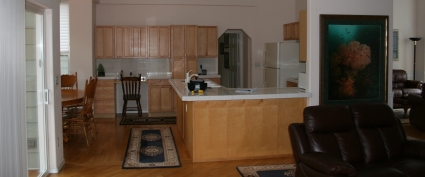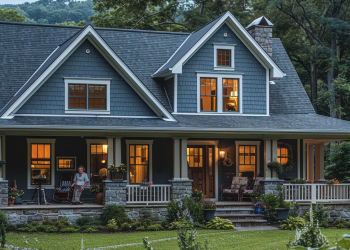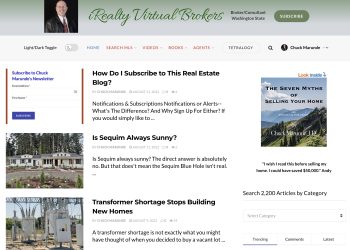“Did I pay too much for my Sequim home in 2007?” This is a question a client asked me today, and since it is relevant to so many Sequim homeowners right now, I think the answer is worthy of posting here. This issue is important to sellers right now, but deep in this story is a huge lesson for buyers. Since I act primarily as a buyer’s agent and never as a dual agent, this article could be the one of the most important articles a buyer will read on this real estate blog.
To answer the question of whether you over paid for your Sequim home, we need to look at the history and put your purchase in context. I looked at the recorded Deed and it shows you closed on March X, 2007 at a price of $300,000. That was the tail end of the boom years in real estate prices. The year 2005 had the most sales in Sequim at the highest prices, and 2006 sales slowed down but prices did not begin to stall out until the impact of the real estate recession began to be felt in the spring and summer of 2007. You purchased at the precise end of the bull market in real estate and at the beginning of the decline.
Sequim Home Value
But there’s another important aspect of valuing your Sequim home, even going back to when you purchased it. Let’s look briefly at this property’s history.
It was built in 1983 at what was probably $55 per square foot or $67,000. Land like this was selling for about $25,000 at that time. With a few other costs, I would estimate that the owners had about $92,00 to $110,000 in this property and home. In November of 1999, they sold it for $142,000. Considering they held the home from 1983 to 1999, or 16 years, they had a very modest profit of roughly $30,000.
From 1999 to 2005 Sequim saw the largest price appreciation of homes in our real estate history. As I’ve said already, those prices did not start dropping significantly until 2007. Some home prices dropped slightly in late 2006 and early 2007, but it was later when we began to see the cumulative effect of the nationwide real estate recession.
When you purchased your Sequim home in March of 2007, in my opinion, it would have increased in value substantially since 1999. The price it sold for in 1999 was $116 per square foot. At the peak of the market this home would have been worth, in my opinion, approximately $170 per square foot, and that is a generous number. That would have been $207,000. That would represent a 45% price appreciation from 1999 to 2007, only 8 years. That’s a gigantic price appreciation. Again, this is a 1983 home and it is very small, only 1,220 square feet, and only 2 bedrooms. In 2007 you could buy a brand new 3 bedroom, 2 bath home in Sequim on one acre for $250,000.
This location is really good, and that does give it more appeal to buyers, but it wouldn’t have dramatically increased the appraised value.
If you take the value I think it really had in 2007 in the spring, which is $207,000 to $225,000 at most, today’s county assessment of $186,000 would be a depreciation of 10% to 17%. In the Sequim area this is typical, although the variation of depreciation in this recession varies quite a bit from home to home. The variables include the area or location, the floor plan, and the quality of materials and labor. Some homes have seen as little as 10% depreciation, but others have seen as much as 50%. The homes hurt the most are the ones that the majority of retirees do not favor, and I’ve written extensively about those homes on this blog. [See Which Sequim Homes Are Selling?]
If I’m correct, and your Sequim home was actually worth $207,000 to $225,000 in the spring of 2007, when you paid $300,000 for it, you overpaid by about $75,000.
Your first thought may be, “Well it appraised for $310,000 when we bought it. How could the appraiser have been so wrong?” My answer is that the appraiser was wrong about this Sequim home. Of course, we now know with overwhelming evidence that many appraisers over appraised homes in those peak years, which I think could be called the “years of the real estate appraisal and mortgage frenzy.” We were all sold a bill of goods by the mortgage industry, appraisers who were only too willing to participate, and Fannie Mae and Freddie Mac and the Wall Street folks who sold and securitized loan portfolios like it was all a Monopoly game.
Buying a Sequim Home and Traps for the Unwary
This all gets to two of my pet peeves, and your case is a perfect text book case that proves my point in dozens of articles on this blog both against dual agency and for a competent and professional buyer’s agent who will truly watch out for your interest.
I see that you bought your Sequim home with an agent from an office other than the listing office, so you did not hire the listing agent as a dual agent. That’s good. Many people don’t realize how that can cause them to over pay for a home. You had a buyer’s agent. But that raises the question, how could your buyer’s agent allow you to over pay so much for this home? This gets to my second pet peeve that I diplomatically write about on this blog in numerous articles. Just because you hire an agent as your buyer’s agent, that doesn’t mean you’re getting the kind of experience and professional competence to negotiate the best and lowest price on your behalf. I write about how important negotiating experience is [Read How To Negotiate Like An Expert], and I think a lot of people don’t comprehend that good negotiations start at the beginning with an examination of the listing price and true fair market value. If your buyer’s agent doesn’t know how to do that exceedingly well and then negotiate from a position of power, you may over pay for your Sequim home. [Read The Truth About Dual Agency]
I realize this doesn’t give you any warm fuzzies, realizing that you over paid for your home, but I hope the reasoning is helpful. Believe me, you are not alone in this dilemma. There are so many other homeowners who fell into precisely the same trap for the unwary that you did. This is why I write so many articles on my Sequim real estate blog warning buyers of traps for the unwary. I honestly believe that I am the most consumer oriented Realtor around. I would rather have my clients know the truth and miss out on a commission than see them over pay or get in some kind of trouble. But for buyers there is much more to the hiring a buyer’s agent, and I write elsewhere about how buyers can really protect themselves when they hire an agent.
I recently met with the buyer of a beautiful Sequim home in a very nice area. We had a wonderful visit, and I was delighted to make a new friend. I met him by sheer coincidence while looking at an adjacent property. What I knew before I met this new Sequimite was that he overpaid for his home by about $125,000. Of course I did not mention this to him. Why make him feel bad now? And I certainly didn’t want to cast aspersions on his real estate agent, after all this little old real estate agent (that would be me) could be wrong about everything. But I think this is another example of his buyer’s agent not assertively representing his client with the kind of professional negotiating skills that would have served this client well. There’s a lot more that could be discussed on this subject and how this kind of thing happens, but the bottom line is that I believe this is another buyer who paid too much for his Sequim home, and in this case that was about $125,000. That’s not exactly chump change, is it? (His agent made a nice commission, and his agent under industry standards probably sent 20% of the commission to the out of state agent who referred him. The two agents are probably BFFs now.)
Lessons for Buying a Sequim Home
There are multiple lessons in these stories, but I would point out two major lessons. First, sellers need to be darn certain they get a listing agent who knows how much to list the property for and not just to kiss butt to get the listing at any price. Not many sellers actually get lucky and sell their homes for more than it is worth, but if you certainly don’t want to be the buyer who over paid. Second, buyers will want to know, not guess, how to hire a buyer’s agent who is competent and professional in every aspect of real estate so they don’t over pay for their home. Unfortunately most buyers don’t know they over paid, and some never figure it out until many years later when they try to sell. Don’t guess what the price of a home is, and be sure you don’t pay too much for your Sequim home. When it comes to buying a Sequim home you do not want to have to say what my mother used to say, “Live and learn.”
Last Updated on April 13, 2012 by Chuck Marunde


































